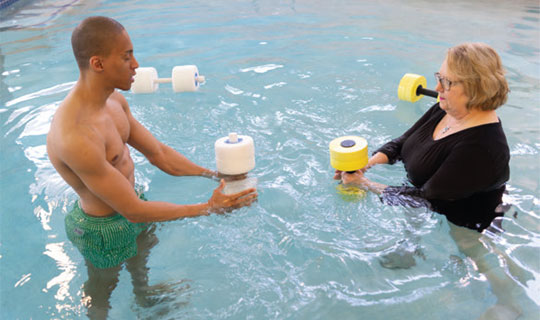Aquatic Therapy Can Help Patients Regain Mobility, Strength, and a Healthier Lifestyle.

Taking a dip in a pool is a great way to unwind in the summer, but it also has therapeutic benefits— especially when the temperature is warm. At the RWJ Fitness & Wellness Center at Robert Wood Johnson University Hospital, patients with a variety of conditions, such as arthritis and obesity, participate in “aquatic therapy,” a form of physical therapy. “Many people with medical conditions stop exercising because they’re fearful to do it without assistance,” says Mary Jo Bronson, PT, DPT, Senior Physical Therapist.
“Aquatic therapy can help them become more confident and can open a door to a more active, healthy lifestyle.” Here’s how patients can benefit:
Arthritis (Osteoarthritis And Rheumatoid Arthritis)
These patients suffer from inflamed joints, chronic pain, a decreased range of motion and weakness. Walking on land can be difficult, and patients are at risk of falls. Arthritis patients can move more easily in the water because it reduces the amount of force on the joints. The water’s buoyancy allows patients to go through the motions of walking and work on skills, such as balance, without the risk of falling.
Postsurgical Patients (Joint Replacement and Spine Surgery)
A small percentage of patients with hip and knee replacements have difficulty bearing full weight and have balance challenges. Aquatic therapy allows them to move more freely and work on balance, which can be challenging on land. Water exercises can also help postsurgical patients become comfortable with everyday movements, such as getting in and out of a chair without putting excessive weight on the joint, for instance. “The water helps to support the core and spinal column, promoting proper body mechanics for the transition to land activities,” says Bronson.
Chronic Pain (Fibromyalgia, Chronic Neck and Back Pain)
These patients often stop participating in their usual activities due to pain, so they lose strength and mobility. Starting an= exercise program in the water (walking and upper and lower extremity workouts, for instance) helps these patients move better without pain and prepares them for land exercises.
Spinal Cord Injuries
Many of these patients are weak, and some are in a wheelchair. Water exercise helps them discover their capacity for movement. “The most important component is psychological,” says John Lancaster, PTA. “When patients are more confident, they can move more freely.” Those with partial spinal cord injuries can work on core stability exercises. “We find that spinal cord injury patients who participate in aqua therapy are better able to perform the activities of daily living, such as cooking and reaching into a cupboard,” says Bronson.
Obesity
Exercising in the water helps to improve mobility, endurance and strength in patients who are obese—and those who have had weight-loss surgery. These patients typically suffer from joint pain and decreased mobility. “After participating in aquatic therapy, they are better able to tolerate landexercise,” says Bronson.
To learn more about aquatic therapy at Robert Wood Johnson University Hospital, visit www.rwjbh.org/rwjuhaquatic.